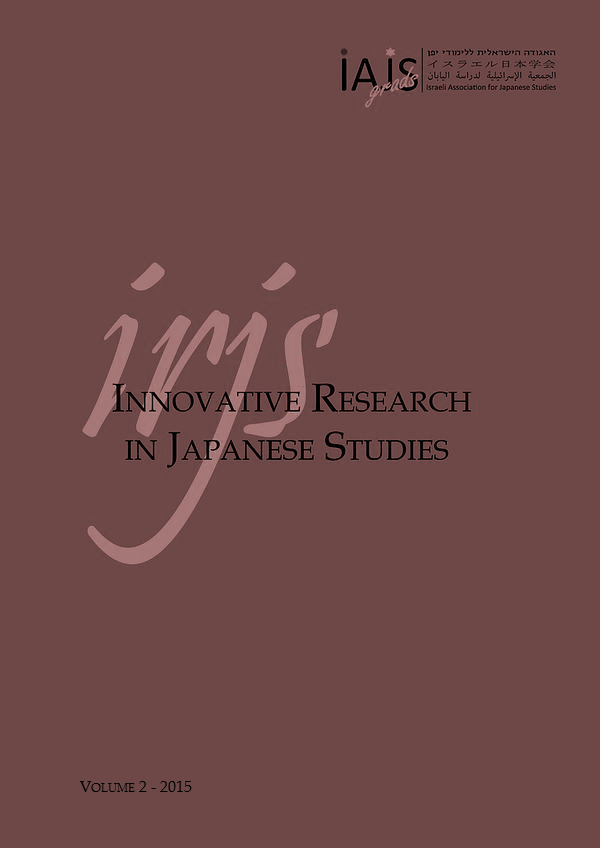Volume 2, Fall 2015
Outgoing Editor: Michal Daliot-Bul
Dear readers of Innovative Research in Japanese Studies,
It is my pleasure to present you with the second volume of our journal.
This unique project would not have been possible without the support of our external reviewers and of our managing staff, in particular our language editor Nikki Littman and the managing editor of this volume, Rotem Ayalon.
This volume offers two interesting articles by graduate students that, in our opinion, show particular promise. The first by Patrick Hein presents a critical analysis of Prime Minister Abe Shinzo's narrative on "healthy nationalism." The second by Yulia (Jules) Shein-Kushnir examines the way in which keitai culture has impacted notions and practices of couplehood.
In addition, this volume includes lecture giving by manga script writer and cultural critic Otsuka Eiji during the most recent IAJS graduate students' methodological workshop which took place at the Hebrew University in May 2015. The talk analyzes the impact of Eisenstein's montage theory on Japanese aesthetics from the 1920s until today. Understanding the impact of foreign influences, such as Eisenstein's montage theory, on Japanese aesthetics is one way of de-exotifying Japanese culture and freeing it from its image as a "Galapagosized" culture.
Finally, as I am stepping down from my position, I wish the incoming editor-in-chief, Dr. Helena Grinshpun, a rewarding journey in her efforts to further develop this wonderful project.
Michal Daliot-Bul
Editor in Chief
Incoming editor:
Dear readers,
I am honored to take the place of Dr. Michal (Miki) Daliot-Bul as Editor-in-chief of the IAJS graduate students' journal Innovative Research in Japanese Studies.
The journal has proved the aspirations behind its conception a big success, creating an accessible platform for graduate students' early forays into academic writing and providing them with thoughtful feedback and attentive guidance. The visible result has been two highly inspiring and thought-provoking collections of papers on an impressively wide range of topics by contributors from Israel and abroad. The less visible — but no less important — outcome includes the raising of academic confidence among graduate students, the strengthening of ties between young researchers and the established scholars involved in the reviewing process, and the exposure of the field of Japanese studies in Israel to the wider academic world.
As the incoming editor, I am faced with the challenge of taking over this ambitious project and moving forward with the inspiring legacy of experiences and insights gathered by the journal's wonderful team. As part of this new leap forward, we have decided to introduce some changes to the character of the journal, namely, to enable authors to publish their works in Hebrew as well as in English. We believe that this will open the window of opportunity to a wider audience of Israeli graduate students and ensure proper representation of excellent papers in Japanese studies that are written in Hebrew.
We truly hope that this fascinating project will continue to draw interest from young researchers and kindle ideas and motivation among the academic community in the field of Japanese studies.
Helena Grinshpun
A Letter from the Editor-in-Chief
Dear readers of Innovative Research in Japanese Studies,
On behalf of all those who have participated over the past year in the production of the first volume of Innovative Research in Japanese Studies, it is with great pleasure and a sense of accomplishment that we launch it online.
By establishing this journal we wanted to create a platform that would allow graduate students (enrolled in Ph.D. and Master programs) a means to practice their writing skills and to experience what it means to get published in the academic world. No less importantly, we hope to deliver to readers around the world a taste of some of the academic interests of young and promising researchers in the field of Japanese Studies.
We were pleasantly surprised to receive submissions from as far away as Latin America and North America, through Europe and the Middle East, all the way to Asia. Many of these submissions showed promise. But what we were looking for, were those manuscripts that demonstrate an outstanding flight of intellectual imagination in delineating a research problem, or those that excel in their analytic examination. Our guiding principle, which is perhaps theadded value of our journal, is that every submission is carefully reviewed byexperienced scholars and that, even in cases of rejection, every contributorreceives detailed feedback on their work. Authors who were asked to revisetheir manuscript were given step-by-step guidance. We were delighted toreceive so many messages of thanks from contributors who appreciated themeaningful reviewing process and the careful feedback.
I would like to thank the anonymous reviewers for their hard work and, ofcourse, our diligent and dedicated staff of graduate students who are makingthis fascinating project possible.
As we send this first volume online, we are already looking forward to welcoming new submissions for ensuing volumes from outstanding graduatestudents who have something to say and want to be heard.
Michal Daliot-Bul
Editor-in-Chief
Submission Deadline, Guidelines and Instructions:
Innovative Research in Japanese Studies new submission guidelines and deadline for our 2016 edition will be announced shortly .
The 2014 & 2015 submissions guidelines can be found here. Please refer to our Frequently Asked Questions for more information.

